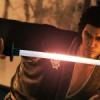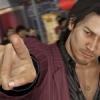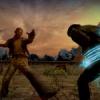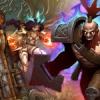The Ryuu Ga Gotoku series, known as Yakuza in the West, is Sega’s long-running action-adventure series, set against the backdrop of the criminal underworld. Think story-driven open-world game meets J-Drama: that’s Ryuu Ga Gotoku.
Although it only has a niche following in the West, in Japan it’s become popular enough that the series sees almost yearly installments; excluding Ishin!, nine RGG games have been released to date. Over the last 3 years I’ve played through eight of those nine games and become a little tired of the series.
Some might argue that my disillusionment is down to having binged through the series; true, I played these games only months apart from each other. But that can’t explain why I left Ryuu ga Gotoku: Ishin! feeling a renewed enthusiasm for the series. In fact I’d go as far to say that Ishin! is the highpoint of the series.
‘Ishin’ is the Japanese word for ‘restoration’, as in the ‘Meiji Restoration’ of 1868 where political power was taken from the Tokugawa Shogunate and ‘restored’ to the Emperor. Restoration is also how the game is known in the western world, and the name we’ll be using for the rest of this review.
At the time, confidence in the Shogunate was crumbling; foreign invaders with advanced military technology were knocking on Japan’s door and many Japanese feared that the country might fall to colonial rule — a situation that the Shogunate—having spent the last 300 years avoiding contact with the outside world—seemed unable to deal with.
Factionalism broke out as different parts of Japan fought for the power to put their own solutions to the ‘foreign problem’ into action. But many felt that a divided Japan was an easy target for foreign invaders and so they sought to unite the country under the Emperor; anyone with enough swords and gunpowder could contest the legitimacy of factional rule, but few could argue against the legitimacy of Imperial lineage. This run-up to this real-life historic event is the context in which Restoration takes place.
This new setting has allowed the writers to wipe the slate clean. Almost every character from the series’ history has been revived and recast here, keeping their signature characteristics but dropping their narrative baggage.
You play as Ryōma Sakamoto (modeled on series protagonist Kazama Kiryuu), a prominent figure of an anti-Shogunate movement. The leader of this movement is killed and Ryōma, having been framed for the murder, flees his home vowing to find the killer. He assumes a new identity, Hajime Saitō, and his quest for vengeance leads him to joining the Shinsengumi; the Shogunate’s elite Samurai crack squad. The revolutionary Sakamoto and the Shinsengumi captain Saitō most certainly existed in real-life, but only in Restoration’s fantastical take on history are they the same person.
Even though Restoration is not historically accurate it draws on history in interesting ways. The characters ooh and ahh over the exotic high tech curiosity of the ‘Fottograff’. And at one point you run into (a parody of) famed 19th century novelist Natsume Sōseki. This is a fascinating era in history; a time of inter- and intra-national tension and the point of transition from rule under the sword, to rule under the gun. It is a shame that this era in history isn’t visited more often in big videogame releases.
The setting and characters are certainly a change from the series norm, but Restoration is different from its predecessors in another deep, fundamental way: structure. Most RGG games are primarily story-driven with lots of flashing lights and amusements on the side. In Restoration the bulk of the experience is the optional side-content which you stumble across when moving between plot markers (which the game tends to place at the opposite ends of the map):
This is a major shake-up to the overarching design for the series that will turn off players who want a tight story-driven game. Restoration is made up compulsive actions that begets more compulsive actions:
You swear you’re done playing for the day and then you see a shiny object you have to pick up, then a temple where you can level up your dash ability, you unlock a new combat skill which you must try out, you get the points needed to unlock new fishing equipment, which in turn nets you the fish you need for the new recipes, and you just happen to find an NPC looking for the food you’re carrying, he gives you a raffle token which wins you some awesome crafting materials, so you upgrade your weapons with the new materials, and whilst you’re at it the store owner tells you about his plot to avenge his brother, so you end up helping him out but not before pissing of a local baron who sets an assassin on you…
…And then 10 hours later it is 4 in the morning and you’ve done next to nothing to progress the story and somehow ended up back on the side of the map where you started. This is the way Restoration gets its claws into you without you realizing it.
Because much of Restoration is compulsive busybody work, and because there is so much to see and do, you’ll find the game has a huge amount of playability but little replayability. But at 60 hours long just clearing the main story (stopping for heavy sidequesting) and a dozen longer to finish the post-game side-content this is unlikely to bother you.
The focus on side-content works in Restoration because the narrative takes a relaxed backseat, creating breathing room and context for all the optional content. In the few instances where narrative urgency is needed the game shuts down side-content to facilitate the story. And although story and side-content sometimes tussle, they are rarely at war with each other.
The focus on side-content also works because the game is hard enough that the sub-systems aren’t extraneous decoration: For example, you can eat out at restaurants for temporary stat boosts to your ATK/DEF. This isn’t new to the series but in Restoration taking advantage of the stat boosts is an important part of evening out the difficulty level; a frivolous part of the series has become a genuine tactical consideration. At least this was my experience from playing the game on Hard; players can always toggle the difficulty down mid-game; a late but welcome addition to the series.
It also helps that the UI and inventory have seen some smart changes that make managing the sub-systems less of a pain. Menus are tabulated for easy navigation, healing and crafting items no longer clog up the same inventory screen, you can sell items directly from your warehouse as well as from your inventory, the map screen can be summoned with a single button press; bliss by a thousand kisses.
All these sub-systems in the game stay relevant because of how they tie back into combat—cooking provides vital healing items, eating provides buffs, crafting improves your weapons and so on—and the combat in Restoration is some of the deepest and most diverse the series has seen:
As you walk around the game you’ll be accosted by groups of weapon bearing baddies attempting to shake you down. You dispatch them using your sword, pistol, the two of them in tandem or (if you’re feeling lucky) your bare hands.
Combat feels good thanks to strong audio-visual hit feedback and sense of weight; bright orange sword marks score enemies bodies on contact; lacerating enemies feels kinesthetically real. Armor cleaves apart and shatters under the weight of your strikes. Enemies fly back, whiplashed off their feet by Bruce Lee style fist strikes. Little touches like the Dualshock 4’s lightbar flashing when you fill your special meter gauge add a layer of visual feedback to go with the kinesthetic; you can normally intuit and feel your way around combat, making it easy to keep track of what’s going on.
But combat doesn’t just look pretty, it’s deep too. The Just Guard ability of the Sword style allows you to repel enemies by timing your guard late. The Barehanded style is incredibly effective when you take advantage of the Parry ability and its invincibility frames quirk. And the Gun-and-Sword style allows you to dash cancel out of your recovery frames; learn how to use it and you’ll become a tireless whirlwind of steel and death.
The only problem with combat is that the lock-on/centering mechanic can be fickle. The idea is you hold down R1 and the enemy you’re looking at becomes the axis which Ryōma strafes around. But sometimes this would lock me into a strafing orbit around an arbitrary invisible point… even when there was only one enemy around. Normally it’s just an inconvenient minor nuisance but sometimes that 1 second is all the enemy needs to put you on the end of a few hits.
In previous installments you played as multiple characters which necessitated multiple tutorials and multiple narrative justifications for how each protagonist came upon each sub-system. In Restoration you play as one character with the depth of four; making combat at any given time deeper at the same time as cutting expositional fat down by three-quarters; this is a leaner, meaner Yakuza game.
In addition, the doubled-up NPC/formal tutorial explanations of Yakuza 5 are gone. In their place is the freedom for the player to figure things out for themselves or, if they feel so inclined, look them up in the in-game encyclopedia at their own pace.
In previous Yakuza games, combat fatigue would set-in as combat was an ineffective way of getting EXP, money and items late into the game; why fight dozens of low level thugs if finding a little girls’ dog took less time and effort but yielded better results? In Restoration combat stays interesting thanks to a steady raft of new ability unlocks, loot drops upgrading to include better items and the new EXP system:
There are two types of EXP in Restoration: regular EXP which is earned in (and poured into) combat and Benevolence which is earned in (and poured into) field exploration. Combat remains necessary well into the game because it’s the only effective way to gain combat-oriented EXP.
In fact, none of the elements in the game become redundant; you’re steadily introduced to upgrades for Benevolence to be poured into, extra options to invest money into and more combat skills to spend EXP on. You won’t reach a point of saturation where you’re so strong, rich or stocked up on items that you can sit easy for the rest of the game; you’ll go from rags to riches and back again quite frequently.
As an added bonus, you can use the PS Vita to help you prop up your finances and restock your inventory with healing items. Restoration allows you to use the cloud to pass your save data between the full game on the PS3/4 and Yakuza Restoration: Free Application on the Vita. Free Application includes modes from Restoration such as dungeon raids, cooking, fishing, weapon crafting and an assortment of mini-games. It’s a great value adding addition to the game that more developers should stand up and take notice of. You can see detailed impressions on Free Application here.
Restoration is a cross-generation release for both the PlayStation 3 and PlayStation 4. The move to the PS4 offers tangible benefits; the technical grunt of the machine allows Restoration to run in 1080P at an unwavering 60FPS. The higher resolution lends gradient to darker colors, making scenes look more natural. And the framerate makes slicing through enemy ranks feel like a kind of gallant sword-ballet on ice. The PS4 version of the game also supports media sharing with a touch of the Share button, but it’s worth noting that this ability only unlocks after completing the main story.
But there’s some inconsistent presentation that technical muscle alone can’t fix. For example, a group of bad guys will spot you and give chase. You make to flee but notice a penny on the ground. You stoop down to pick it up and the enemies, so awestruck by your ability to find lose change, are erased from existence. Heck, sometimes NPCs materialize in and out of existence even when there are no pennies around to explain things away. Some of the simulations in the game don’t and can’t take place concurrently which leads to bizarre situations like this.
I say the presentation is ‘inconsistent’ because sometimes Restoration shows flashes of brilliance: You’ll be walking by an alleyway and hear a woman call out ‘Mr Samurai, you have to help!’. She hurriedly points at a group of people in the distance. You squint and realize that someone is being kicked about by some ne’er do wells. Time to intervene. And all this happens without the game taking any control from you: it’s completely organic.
The same inconsistencies can be seen on the sound front. There is a lot of dynamic NPC chatter to hear as you walk around the game world; when you start the game the townspeople gossip about the Shinsengumi in hushed undertones. As you do good around town NPCs you helped out recognize Ryōma, and shopkeepers will call out to him by name. It’s a nice touch. But on the other hand almost all the sidequests are unvoiced. And even in conversations that are voiced, silences are not enunciated with any facial expressions, inhaling of breath or anything else that would make them ‘readable’.
There is definitely a presentation difference between the side-content and main story here but both parts of the game benefit from some stronger (but inconsistent) writing than the series has seen in a while. The main story sees Ryōma grow out from being obsessed with his personal vendetta to selflessly setting the course of Japan’s future. And the sidequests rely less on whimsical one-dimensional characters and punch-lines (that you can see from a mile away) than in previous games.
But this is a case of two steps forward and one-back. The story is pretentious in the most literal sense of the word; there is pretense but no delivery. In one scene Ryōma is handed a pistol, “a weapon of equality”. In another, a character monologues on the necessity of sacrifice for the greater good. But these themes never quite pan out and whatever the writers wanted to say about them comes across as muddled at best.
The ending in particular might seem like cop-out to some. The bad guy has legitimate justifications for what they are doing and asks the protagonists how they would solve the ‘foreign problem’ in his shoes. Ryōma replies to the effect of “We’ll think of something” and then splats him… It’s supposed to be an uplifting, positive message about the unlimited potential of the future but I couldn’t help but think ‘holy shit Ryōma, you really didn’t think this out, did you?’.
Despite the few inconsistencies in its presentation, Yakuza: Restoration is still a fantastic game. Sure, the story isn’t quite as fully realized as it wanted to be, but this is a game that shines because it gets a lot of the fundamentals right. Interdependence of game elements is held together by a well-balanced difficulty level. The UI is player-friendly but smart in how understated is. Combat looks good, feels solid and has depths that the inquisitive can plunder without any handholding. The issues I have with the game don’t hurt the final product that much, but they do feel like missed opportunities to elevate a great game to an amazing one. For now, Yakuza: Restoration will have to settle for being the best Yakuza game there is. And that’s not so bad.











Pingback: Yakuza 2 Retrospective Review | Continue Play